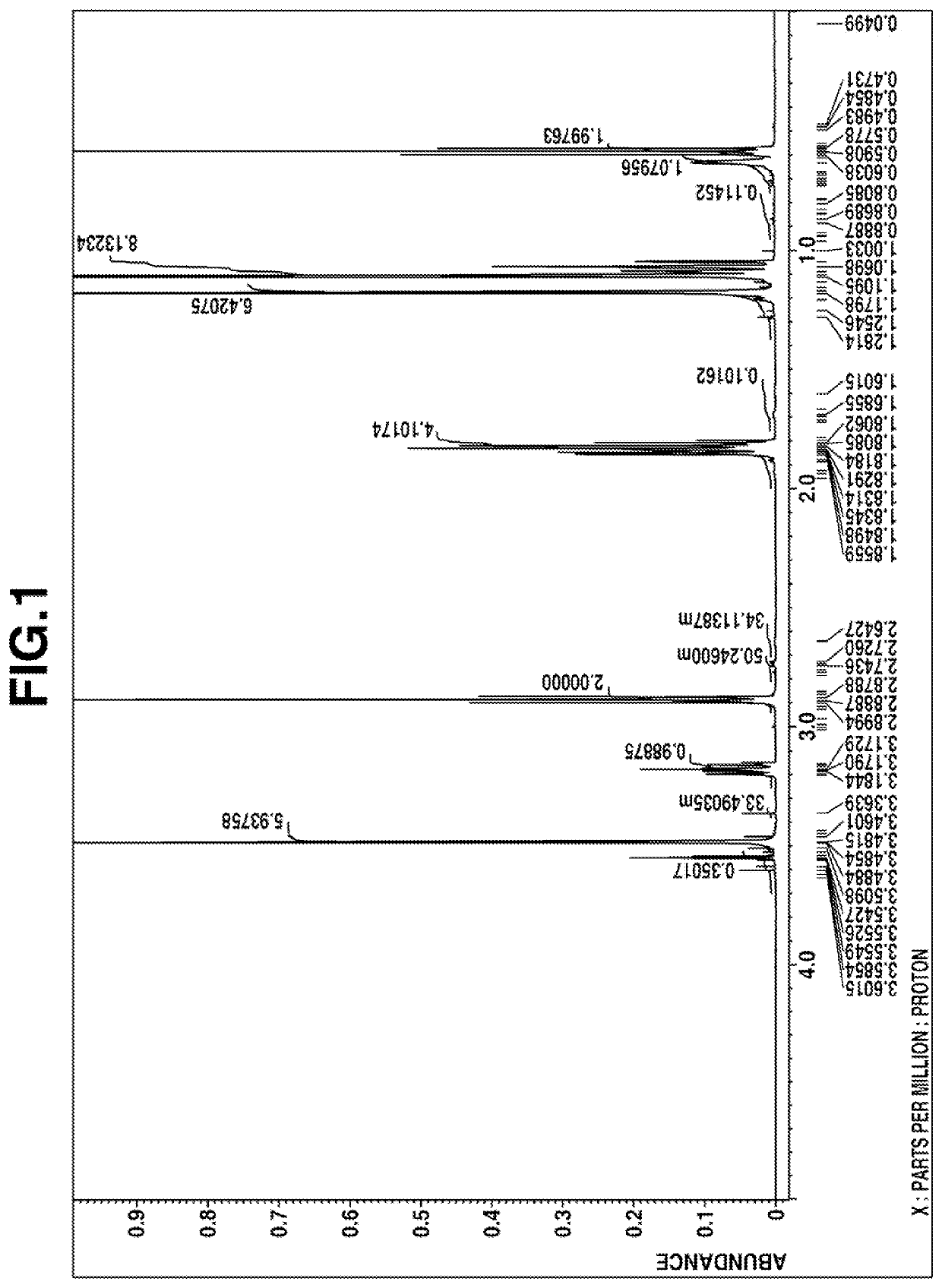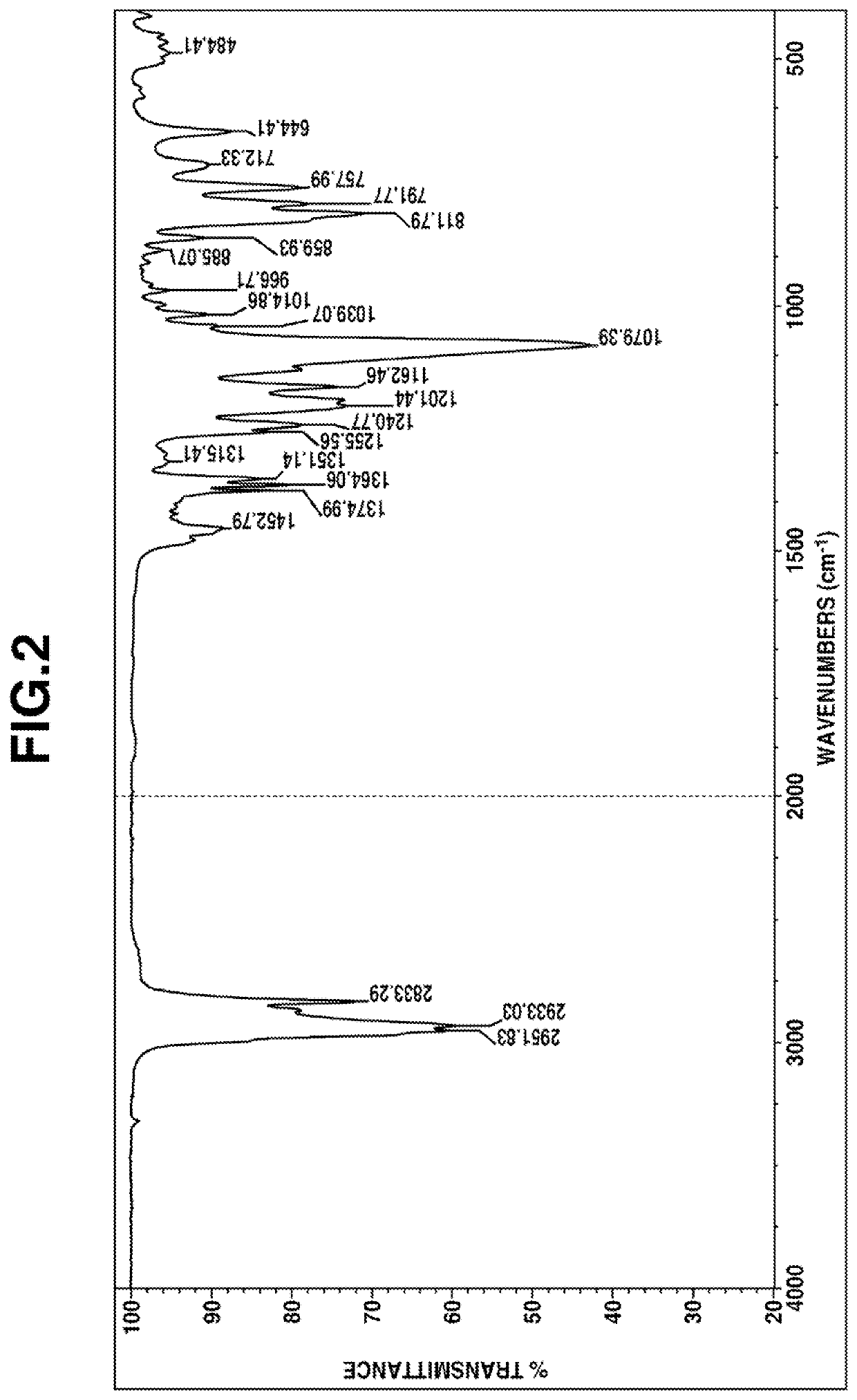Organosilicon compound having cyclic silazane structure, composition containing the same, and method for producing the same
a technology of organic silazane and structure, applied in the field of organic silazane structure, composition containing the same, and production method, can solve the problems of reducing productivity, burdening the environment, and generating a large amount of alcohol
- Summary
- Abstract
- Description
- Claims
- Application Information
AI Technical Summary
Benefits of technology
Problems solved by technology
Method used
Image
Examples
example 1
Synthesis of 2,2-dimethoxy-1-(2,2,6,6-tetramethyl-4-piperidinyl)-1-aza-2-silacyclopentane
[0170]A flask equipped with a stirrer, reflux condenser, dropping funnel, and thermometer was charged with 625.1 g (4.000 mol) of 4-amino-2,2,6,6-tetramethylpiperidine and heated to 150° C. After the internal temperature was stabilized, 198.7 g (1.000 mol) of chloropropyltrimethoxysilane was added dropwise over 10 hours, and the mixture was stirred at the stabilized temperature for 50 hours. After cooling the mixture to room temperature, 4-amino-2,2,6,6-tetramethylpiperidine hydrochloride generated by the reaction was removed by filtration to obtain 611.7 g of a precursor reaction liquid.
[0171]Next, a flask equipped with a stirrer, reflux condenser, fractionating head, and thermometer was charged with 611.7 g of the precursor reaction liquid and 7.6 g (0.040 mol) of a solution of sodium methoxide in methanol (28 wt % sodium methoxide), and distillation was performed while distilling off generate...
example 2
Synthesis of 2,2-dimethoxy-1-(2,2,6,6-tetramethyl-4-piperidinyl)-1-aza-2-silacyclopentane
[0174]A flask equipped with a stirrer, reflux condenser, fractionating head, and thermometer was charged with 159.3 g (0.500 mol) of N-[3-(trimethoxysilyl)propyl]-2,2,6,6-tetramethyl-4-aminopiperidine and 3.8 g (0.020 mol) of a solution of sodium methoxide in methanol (28 wt % sodium methoxide) at room temperature, and distillation was performed while distilling off generated methanol to obtain 104.9 g of a colorless and transparent fraction having a boiling point of 178 to 179° C. / 5.0 kPa.
[0175]The obtained fraction was analyzed by gas chromatography, and it was confirmed that the purity of 2,2-dimethoxy-1-(2,2,6,6-tetramethyl-4-piperidinyl)-1-aza-2-silacyclopentane was 99.6%.
example 3
Production of a Mixture of 2,2-dimethoxy-1-(2,2,6,6-tetramethyl-4-piperidinyl)-1-aza-2-silacyclopentane and N-[3-(trimethoxysilyl)propyl]-2,2,6,6-tetramethyl-4-aminopiperidine
[0176]A flask equipped with a stirrer, reflux condenser, fractionating head, and thermometer was charged with 159.3 g (0.500 mol) of N-[3-(trimethoxysilyl)propyl]-2,2,6,6-tetramethyl-4-aminopiperidine and 0.9 g (0.005 mol) of a solution of sodium methoxide in methanol (28 wt % sodium methoxide) at room temperature, and distillation was performed while distilling off generated methanol to obtain 129.4 g of a colorless and transparent fraction having a boiling point of 183 to 184° C. / 5.0 kPa.
[0177]The obtained fraction was analyzed by gas chromatography, and it was confirmed that the ratio of area % of 2,2-dimethoxy-1-(2,2,6,6-tetramethyl-4-piperidinyl)-1-aza-2-silacyclopentane to N-[3-(trimethoxysilyl)propyl]-2,2,6,6-tetramethyl-4-aminopiperidine was 72:28.
PUM
| Property | Measurement | Unit |
|---|---|---|
| pressure | aaaaa | aaaaa |
| temperature | aaaaa | aaaaa |
| temperature | aaaaa | aaaaa |
Abstract
Description
Claims
Application Information
 Login to View More
Login to View More - R&D
- Intellectual Property
- Life Sciences
- Materials
- Tech Scout
- Unparalleled Data Quality
- Higher Quality Content
- 60% Fewer Hallucinations
Browse by: Latest US Patents, China's latest patents, Technical Efficacy Thesaurus, Application Domain, Technology Topic, Popular Technical Reports.
© 2025 PatSnap. All rights reserved.Legal|Privacy policy|Modern Slavery Act Transparency Statement|Sitemap|About US| Contact US: help@patsnap.com



